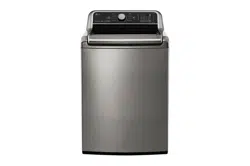Documents: Go to download!
User Manual
- User Manual - (English, French, Spanish)
- Energy Guide - (English)
- Specification - (English)
- INSTALLATION
- OPERATION
- SMART FUNCTIONS
- MAINTENANCE
- TROUBLESHOOTING
Table of contents
User Manual Washing Machine
PRODUCT OVERVIEW
Parts
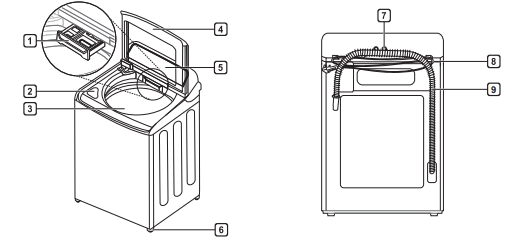
1 Detergent Dispenser
2 Liquid Bleach Compartment
3 Tub
4 Lid (Door)
5 Control Panel
6 Leveling Feet
7 Water Inlets
8 Power Cord
9 Drain Hose
Accessories
Included Accessories

Required Accessories
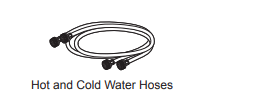
NOTE
- The images in this guide may be different from the actual components and accessories, which are subject to change by the manufacturer without prior notice for product improvement purposes.
- For your safety and for extended product life, use only authorized components. The manufacturer is not responsible for product malfunction or accidents caused by the use of separately purchased unauthorized components or parts.
INSTALLATION
Tools Needed

Installation Overview
Please read the following installation instructions first after purchasing this product or transporting it to another location.
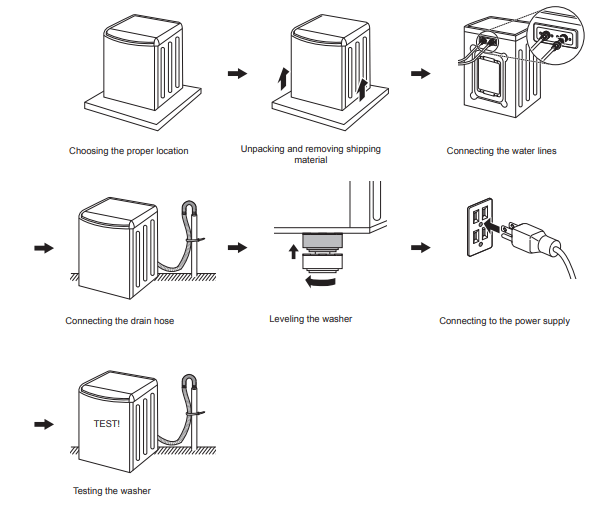
Product Specifications
The appearance and specifications listed in this manual may vary due to constant product improvements.

WARNING :
- Moving or installation of the appliance requires two or more people. Failure to follow these instructions may result in injury.
- Store and install the appliance where it will not be exposed to temperatures below freezing or exposed to outdoor weather conditions. Failure to follow this warning can cause product or part failure, serious injury, fire, electric shock, or death.
- Properly ground the washer to conform with all governing codes and ordinances. Failure to follow this warning can cause serious injury, fire, electric shock, or death.
- To reduce the risk of electric shock, do not install the appliance in humid spaces. Failure to follow this warning can cause serious injury, fire, electric shock, or death.
- To ensure proper airflow, do not block the large opening on the bottom of the washer with carpeting or other materials.
- Do not remove the ground prong. Do not use an adapter or extension cord. Plug into a grounded 3-prong outlet. Failure to follow this warning can cause serious injury, fire, electric shock, or death.
- Certain internal parts are intentionally not grounded and may present a risk of electric shock only during servicing. Service personnel-do not contact the following parts while the appliance is energized. : pump, motor, noise filter cover, and heater (on applicable models)
Choosing the Proper Location
Install the washer on a solid floor that is strong and rigid enough to support the weight of the washer, even when fully loaded, without flexing or bouncing. If the floor has too much flex, you may need to reinforce it to make it more rigid. If the floor is not solid, it may cause severe vibration and noise.
NOTE
- Before installing the washer, make sure the floor is clean, dry and free of dust, dirt, water and oil so the washer feet cannot slide easily. Leveling feet that can move or slide on the floor can contribute to excess vibration and noise due to poor contact with the floor.
- Allow for sufficient space between the walls and the washer for installation.
Power Outlet
- The power outlet must be within 60 inches (1.5 m) of either side of the washer.
- The appliance and outlet must be positioned so that the plug is easily accessible.
- Do not overload the outlet with more than one appliance.
- The outlet must be grounded in accordance with current electrical wiring codes and regulations.
- Use a time-delay fuse or circuit breaker.
NOTE
- It is the personal responsibility and obligation of the product owner to have a proper outlet installed by a qualified electrician
Flooring
- To minimize noise and vibration, the washer must be installed on a solidly constructed floor.
- Allowable slope under the entire washer is a maximum 1 inch difference from side to side or from front to back.
- Installing on carpeting and soft tile surfaces is not recommended.
- Never install the washer on a platform or weakly supported structure.
NOTE : The washer must be installed on firm flooring to minimize vibration during the spin cycle. Concrete flooring is best, but a wood floor is sufficient, provided it is built to FHA standards.
Floor Installation
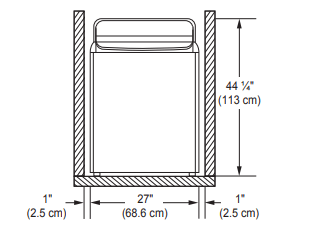
To ensure sufficient clearance for water lines, the drain line and airflow, allow minimum clearances of at least 1 inch (2.5 cm) at the sides and 4 inches (10 cm) behind the unit. Be sure to allow for wall, door, or floor moldings that may increase the required clearances.
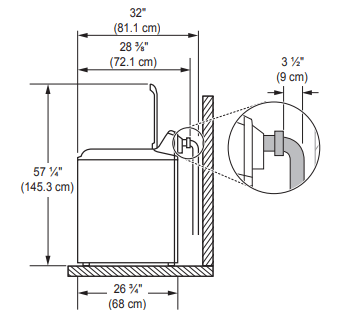
- Minimum vertical space from floor to overhead shelves, cabinets, ceilings, etc., is 58 inches (147 cm).
Unpacking and Removing Shipping Material
Unpack all shipping materials from the washer for proper operation and inspect it for shipping damage.
1. Lift the washer off the foam base.
After removing the carton and shipping material, lift the washer off the foam base. Make sure the plastic tub support comes off with the base and is not stuck to the bottom of the washer.

If you must lay the washer down to remove the base packaging materials, always protect the side of the washer and lay it carefully on its side. Do not lay the washer on its front or back.

2. To prevent damage, do not remove the foam block containing the owner’s manual, parts, and laundry product samples from the washer tub until the washer is in the final location.
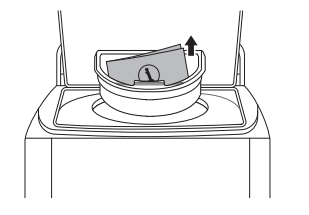
NOTE : Once removed, save the foam block for future use. If the washer needs to be moved, the foam block will help prevent damage during transportation.
3. Unfasten the power cord from the back of the washer.
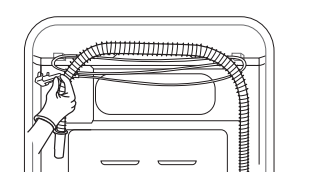
Connecting the Water Lines
To avoid the risk of costly water damage, purchase and install new inlet hoses when installing the washer.
1. Check the fittings and seals.
Inspect the threaded fitting on each hose and make sure there is a rubber seal in place in both ends of each hose to prevent leaking.
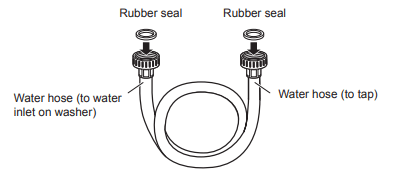
2. Connect the water supply hoses.
Connect the water supply hoses to the hot and cold water faucets tightly by hand and then tighten another 2/3 turn with pliers. Connect the blue hose to a cold water faucet and the red hose to a hot water faucet.

3. Flush out the inlet hoses.
After connecting the inlet hoses to the water faucets, turn on the water faucets to flush out foreign substances (dirt, sand or sawdust) in the water lines. Let water drain into a bucket, and check the water temperature to make sure you've connected the hoses to the correct faucets.
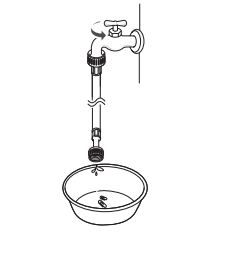
4. Attach the water lines to the back of the washer.
Attach the hot water line to the hot water inlet on the back of the washer. Attach the cold water line to the cold water inlet on the back of the washer. Tighten the fittings securely. Turn ON both faucets all the way and check for leaks at both ends of the hoses.

Warning:
- Do not overtighten the hoses or cross-thread the hose fittings. Overtightening or cross-threading can damage the valves or couplings, resulting in leaking and property damage.
- Do not reuse old hoses. Use only new hoses when installing the washer. Old hoses could leak or burst causing flooding and property damage. Contact an LG Customer Information Center for assistance in buying hoses.
Note :
- Periodically check the hoses for cracks, leaks, and wear, and replace the hoses every five years. Do not stretch the water hoses intentionally, and make sure that they are not pinched, crushed or kinked by other objects.
- Water supply pressure must be between 20 psi and 120 psi (138 – 827 kPa). If the water supply pressure is more than 120 psi, a pressure reducing valve must be installed.
- To provide optimum washing performance, the hot water temperature should be set at 120 – 135 °F (48 – 57 °C) and the cold at 60 °F (15 °C).
- The washer should never be installed or stored in a location subject to freezing temperatures. Damage to the water lines and internal mechanisms of the washer can result. If the washer was exposed to freezing temperatures prior to installation, allow it to stand at room temperature for several hours before use and check for leaks prior to operation.
- Do not use flood-preventing hoses with auto shutoff devices. The devices can be tripped during fill and prevent the machine from filling properly
Connecting the Drain Hose
Connect the drain hose to either a standpipe or laundry tub.
NOTE
- The drain hose should always be properly secured. Failure to properly secure the drain hose can result
- The drain must be installed in accordance with any applicable local codes and regulations.
- Make sure that the drain hose is not stretched, pinched, crushed, or kinked.
- Do not install the drain hose with the end lower than 29.5 inches (75 cm) or higher than 96 inches (244 cm) above the bottom of the washer or more than 60 inches (152 cm) away from the washer.
- Never create an airtight seal between the hose and the drain with tape or other means. If no air gap is present, water can be siphoned out of the tub resulting in poor wash/rinse performance or clothing damage.
Option 1: Standpipe
1. Insert the end of the drain hose into the standpipe.
2. Use the provided tie strap to secure the drain hose in place.
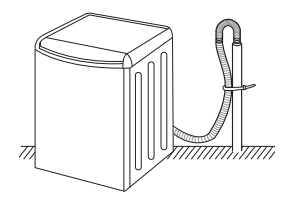
3. If the water valves and drain are built into the wall, fasten the drain hose to one of the water hoses with the tie strap provided (ribbed side on inside).
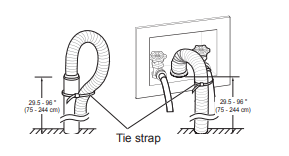
CAUTION : Do not insert the end of the drain hose into the standpipe more than 8 inches (20 cm). Doing so can cause siphoning, odors, or improper draining.
Option 2: Laundry Tub
1. Hang the end of the drain hose over the side of the laundry tub.
2. Use the provided tie strap to secure the drain hose in place.
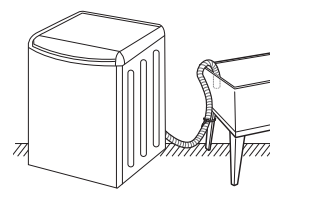
Leveling the Washer
The tub of the washer spins at very high speeds. To minimize vibration, noise, and unwanted movement, the floor must be a level, solid surface.
NOTE
- Adjust the leveling feet only as far as necessary to level the washer. Extending the leveling feet more than necessary can cause the washer to vibrate.
- Before installing the washer, make sure that the floor is clean, dry and free of dust, dirt, water and oil so the washer feet cannot slide easily. Feet that move or slide on the floor can contribute to excessive vibration and noise due to poor contact with the floor.
1. Position the washer in its final location.
Take special care not to pinch, strain, or crush the water and drain lines. If you have a carpenter’s level, you can use it to check that the washer is level. The slope beneath the washer should not exceed 1 inch, and all four leveling feet must rest firmly on the floor.
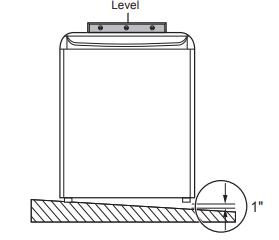
2. Open the lid (door) and look from above to see if the tub is centered.
If the tub is NOT centered, readjust the front feet. If you have a level, check the washer with the level.
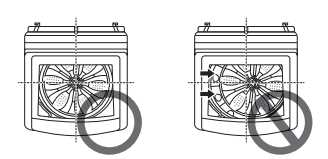
NOTE
- To check if the washer is level from side to side, place a level on the back edge of the lid (door).
- To check if the washer is level from front to back, place a level at the side of the washer on the edge where the cabinet side meets the top cover. Do not place the level on the top of the lid (door). Using these surfaces will result in the washer being unlevel.
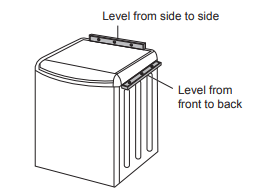
3. Adjust the lower leveling feet.
Turn in one direction to raise the washer or the other direction to lower it.

4. Recheck the washer’s levelness.
Push or rock the top edges of the washer gently to make sure the washer does not rock. If the washer rocks, repeat steps 1-3.
CAUTION
- Using the washer without leveling it may cause excess vibration and noise, leading to a machine malfunction.
- Extend the leveling feet only to level the washer. If you extend the leveling feet unnecessarily, it may cause abnormal vibration of the washer.
NOTE : If the washer is not level, the lid (door) may not stay open properly. If this happens, extend the front leveling legs until the washer is level from front to back.
Connecting to the Power Supply
The washer should be plugged into a 120-VAC, 60 Hz grounded 3-prong outlet. Plug in the washer.
WARNING :
- Do not use a worn or damaged power cord or power plug. Replace or repair it immediately. Failure to do so may result in death, fire, electric shock, or malfunction.
- Do not modify the power cord and plug provided with the appliance. Do not damage it when installing or moving the washer. Doing so may result in death, fire, electric shock, or malfunction.
- Make sure that the washer is grounded.
- Connect this washer to a grounded outlet conforming to the rating prior to use. Failure to do so may result in fire, electric shock, or malfunction.
- Do not damage or cut off the ground prong of the power cord. Doing so may cause death, fire, electric shock, or product malfunction.
- Improper connection of the equipment-grounding conductor can result in risk of electric shock. Check with a qualified electrician or service technician if you are in doubt as to whether the appliance is properly grounded. If it does not fit the outlet, have a proper outlet installed by a qualified electrician.
- The appliance and outlet must be positioned so that the plug is easily accessible.
- Do not use adapters or extension cords. Doing so may result in serious injury, fire, electric shock, or death.
- For best performance, plug the washer into its own individual outlet. This helps prevent overloading house wiring circuits which could cause a fire hazard from overheated wires.
- If necessary, use a new, UL-listed 3-prong adapter or 3-wire extension cord with a 3-prong (grounding) plug rated at no less than the branch circuit. Do not use an extension cord longer than 3 feet. Failure to follow these warnings may result in serious injury, fire, electric shock, or death.
Testing the Washer
Check if the washer is properly installed and run a test cycle.
1. Make sure the tub is empty. Do not load anything in the tub for this test.
2. Press the Power button.
3. Press and hold the Spin and Soil buttons simultaneously until an appears in the display
appears in the display
 Initial test
Initial test
 Previous test result was good.
Previous test result was good.
 Previous test was ended with an error.
Previous test was ended with an error.
NOTE :
 is displayed first, and ,
is displayed first, and ,  is displayed.
is displayed.- The indication is different for each model.
4. Press the Start/Pause button. The washer will start the test, which will last about 3 minutes. The test automatically checks the water inlet hoses and the drain hose.
5. Check the display for results. If error code is displayed, refer to the following guide.
 Fully open the water faucets. Straighten out any kinks in the inlet hoses and make sure the hoses are not pinned against the wall or under the washer.
Fully open the water faucets. Straighten out any kinks in the inlet hoses and make sure the hoses are not pinned against the wall or under the washer.
 Straighten out any kinks in the drain hose and make sure the hose is not pinned against the wall or under the washer. Remove and flush out the drain hose to remove clogs. Adjust or repair the drain. Maximum drain height is 96 inches.
Straighten out any kinks in the drain hose and make sure the hose is not pinned against the wall or under the washer. Remove and flush out the drain hose to remove clogs. Adjust or repair the drain. Maximum drain height is 96 inches.
6. End of cycle.
At the end of the test cycle, will display. The test cycle will end and the washer will shut off automatically after a short delay.
will display. The test cycle will end and the washer will shut off automatically after a short delay.
OPERATION
Using the Washer
WARNING : To reduce the risk of fire, electric shock, or injury to persons, read the SAFETY INSTRUCTIONS before operating this appliance.
1. Sort laundry and load the washer.
Sort laundry by fabric type, soil level, color and load size, as needed. Open the lid (door) and load items into the washer.
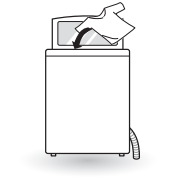
2. Add cleaning products.
Add the proper amount of HE (High-Efficiency) detergent to the detergent dispenser. If desired, add bleach or fabric softener to the appropriate dispensers.
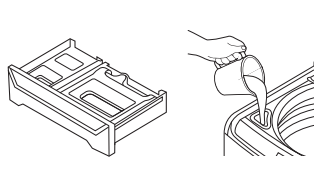
3. Turn on the washer.
Press the Power button to turn on the washer. The lights above the cycle buttons will illuminate and a chime will sound.
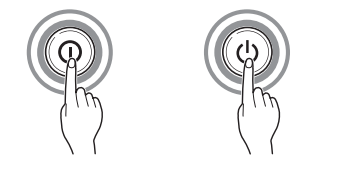
4. Select a cycle.
Turn the cycle selector knob or press the cycle buttons repeatedly until the desired cycle is selected. The preset wash temperature, spin speed, soil level and option settings for that cycle are shown.
- Pressing the Start/Pause button without selecting a cycle will cause the Normal cycle to begin immediately.
5. Adjust settings.
Default settings for the selected cycle can now be changed, if desired, using the cycle modifier and option buttons.
NOTE : Not all modifiers and options are available on all cycles. A different chime sounds and the LED does not light up if the selection is not allowed.
6. Begin cycle.
Press the Start/Pause button to begin the cycle. The lid (door) locks, and the washer agitates briefly without water to measure the weight of the load.
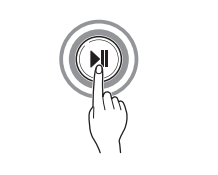
7. Additional garments can be added to the tub while the Add Garment light is on.
The Add Garment light illuminates near the beginning of the wash cycle to indicate when it is safe to add items to the load. Press the Start/Pause button to pause the cycle and add garments to the load. Press the Start/Pause button to resume the cycle.
NOTE : Adding items after the Add Garment light turns off may result in poor wash performance.
8. End of cycle.
When the cycle is finished, a melody sounds. Immediately remove the clothing from the washer to reduce wrinkling.
- If the washer includes lint filters, remember to check them after every 2 to 3 loads.
Sorting Laundry
CAUTION :
- The washer can be fully loaded, but the tub should not be tightly packed with items. The lid (door) of the washer should close easily.
- Use the Bedding cycle for buoyant or nonabsorbent items such as pillows or comforters. Failure to follow this caution can result in leakage.
- Clothing or articles that are waterproof or water resistant must be washed in the Waterproof cycle only. (e.g. water resistant clothing, mattress covers, outdoor clothes, plastic mats, etc.) Otherwise, it may result in personal injury or damage to the washer, clothes, walls, floor, and surrounding objects due to abnormal vibration.
Grouping Similar Items
For the best washing results, and to reduce the possibility of damage to clothing, care should be taken to sort the clothing into loads that are made up of similar items.
Mixing different fabric types and/or soil levels can result in poor wash performance, color transfer, discoloration, fabric damage or linting. Fabrics should be sorted into groups as described below.
Colors
Sort articles by color. Wash dark clothes together in a separate load from light colors or whites. Mixing dark clothes with light clothes can result in dye transfer or discoloration of the lighter clothes.
Soil Level
Wash heavily soiled clothing together. Washing lightly soiled clothing in the same load with heavily soiled clothing could result in poor wash performance for the lightly soiled clothing.
Fabric Type
Delicate articles should not be mixed with heavy or sturdy fabric types. Washing heavy fabrics in a delicate load can result in poor wash performance for the heavy fabrics and possible damage to the delicates.
Lint Type
Some fabrics attract and bind lint to them while others give off lint in the laundry process. Avoid mixing these lint collectors and lint producers in the same load. Mixing these fabrics will result in pilling and linting on the lint collectors. (For example, lint collector—knit sweater; lint producer—terry cloth towels.)
Sort Laundry
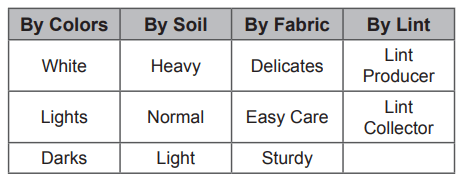
Fabric Care Labels
Many articles of clothing include a fabric care label. Using the chart below, adjust the cycle and option selections to care for your clothing according to the manufacturer’s recommendations.
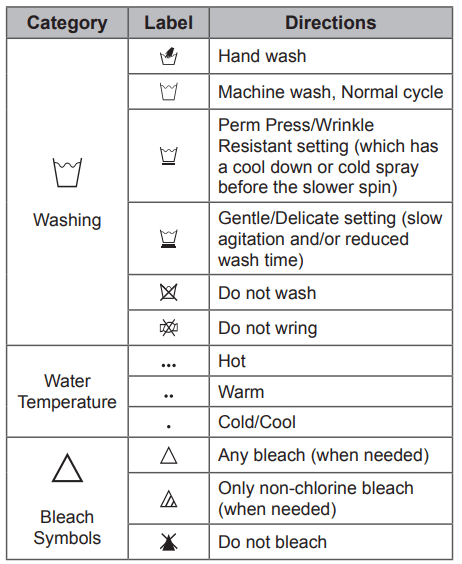
Loading the Washer
- Check and empty pockets. Paper clips, coins, matches, etc. can damage clothing and the washer.
- Close zippers and hooks, and tie drawstrings to prevent snagging or tangling of clothes.
- Pretreat heavily stained areas for best results.
- Combine large and small items in a load. Load large items first. Large items should not be more than half of total load.
- Wash thick, bulky items individually. Heavy blankets, comforters, bedspreads, or pet beds can get tangled or cause an unbalanced load if combined with other items.
- The washer can be fully loaded, but the tub should not be tightly packed with items. The lid (door) of the washer must close easily.
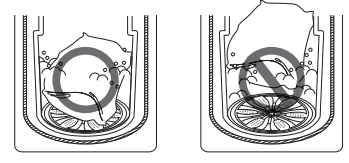
- Do not wash single small items. Add 1-2 similar items to the load to prevent an out-of-balance load.
- Clothing or articles that are waterproof or water resistant must be washed in the Waterproof cycle only. (e.g. water resistant clothing, mattress covers, outdoor clothes, plastic mats. etc) Otherwise, It may result in personal injury of damage to the washer, clothes, walls, floor, and surrounding objects due to abnormal vibration.
- Wash small, light items in a mesh bag. Small items can get caught in the impeller at the bottom of the tub, and brassiere hooks can damage other items or the tub.
- Brush off heavy soil, dust, and hair from items before washing. Excess dirt or sand can abrade other fabrics and lead to poor wash performance.
- The washer will not fill or operate with the lid (door) open.
- Use the Bedding cycle for large or bulky items such as poly-filled jackets, comforters, pillows, etc. These items may not be as absorbent as other laundry items and should be sorted into a separate wash load for optimal results.
- Bulky items should be placed as far down in the tub as possible for optimal results. Always place buoyant items at the bottom of the tub. The washer will automatically detect the load size. Because of the high efficiency wash system, the water level may not completely cover the load.
- Do not overload the tub. Clothes should fit loosely in the tub under the maximum fill line. Loading clothes over the fill line may result in damage to clothing and the washer.
- Load clothes loosely, and do not overfill the tub. Clothes need room to circulate in order to get clean.
- Do not press down on items while stacking them in the tub.
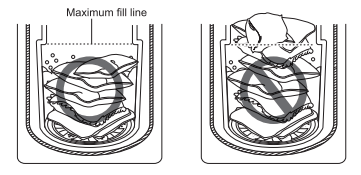
- For best performance, load clothes as shown.
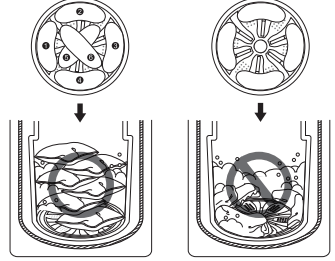
Adding Cleaning Products
About the Dispensers
The automatic dispenser consists of two compartments which hold:
- Liquid fabric softener
- Liquid or powdered detergent for main wash
Using the Detergent and Softener Dispensers
To add detergent and fabric softener to the automatic dispenser
1. Open the dispenser drawer.
2. Load the laundry products into the appropriate compartments.
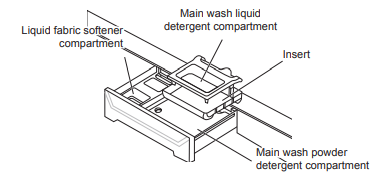
3. Close the drawer completely before starting the cycle.
• Be careful not to catch a hand in the drawer while closing.
Main Wash Detergent Compartment
This compartment holds laundry detergent for the main wash cycle. Either powdered or liquid detergent may be used in this compartment. The detergent is added to the load at the beginning of the cycle. Always use HE (High-Efficiency) detergent with your washer.
NOTE
- Never exceed the manufacturer’s recommendations when adding detergent. Using too much detergent can result in detergent buildup in clothing and the washer.
- When using liquid detergent, make sure the liquid detergent compartment and insert are in place. Do not exceed the maximum fill line.
- When using powdered detergent, remove the insert and liquid detergent compartment from the dispenser. Powdered detergent will not dispense with the liquid detergent compartment and insert in place.
- If you use a detergent that does not dissolve easily or a detergent with high viscosity, it will leave a residue and clog the dispenser.
Fabric Softener Compartment
This compartment holds liquid fabric softener, which is automatically dispensed during the final rinse cycle.
NOTE
- Do not exceed the manufacturer’s recommendations when adding softener. Using too much fabric softener can result in buildup in clothing and the washer. Either powdered or liquid fabric softener may be used.
- Follow the manufacturer’s recommendations when adding fabric softener. Do not exceed the maximum fill line. Using too much fabric softener may stain clothes.
- Dilute concentrated fabric softeners with warm water.
- Never pour fabric softener directly onto the load or into the tub.
Using the Liquid Bleach Dispenser
The bleach dispenser is a separate compartment at the left front of the tub opening.
Type 1
The bleach dispenser is connected to the inlet valve. The bleach is automatically diluted and dispensed at the proper time in the wash cycle.
NOTE : The dispenser is activated twice to ensure complete dispensing of the bleach. Any liquid remaining in the dispenser at the end of the cycle is water, not bleach.
Type 2
When you pour the bleach into the bleach dispenser, the bleach is immediately added to the tub as it fills with water, safely diluting the bleach.
NOTE : The dispenser cover cannot be removed. To clean the cover, wipe it with a damp paper towel.
1. Check clothing care labels for special instructions.
2. Measure liquid bleach carefully, following instructions on the bottle.
• High-efficiency washers use less water, so less bleach is needed. One half cup is enough for most loads.
3. Carefully pour the pre-measured amount of bleach directly into the bleach dispenser.
• If you are using powdered bleach of any kind, pour it directly into the tub before adding the laundry. Never add powdered bleach to the liquid bleach dispenser.
NOTE
- Do not add powdered bleach to this dispenser. The bleach dispenser is designed to dispense liquid bleach only. Powdered or liquid color-safe bleach will not dispense properly.
- Do not place laundry items on top of the bleach dispenser when loading and unloading the washer.
- Always follow the manufacturer’s recommendations when adding bleach. Never add more than one cup and do not exceed the maximum fill line since this can cause the bleach to be dispensed immediately, resulting in damage to fabrics. Using too much bleach can damage fabrics.
- Never pour undiluted liquid chlorine bleach directly onto the load or into the tub. Fabric damage can occur.
- Do not use color-safe bleach or Oxi products in the same cycle with liquid chlorine bleach.
Detergent Use
- This washer is designed for use with only HE (HighEfficiency) detergents. HE detergents produce fewer suds, dissolve more efficiently to improve washing and rinsing performance, and help to keep the interior of the washer clean. Using detergent that is not HE may cause oversudsing and unsatisfactory performance which could result in error codes, cycle failure, and machine damage.
- For proper wash performance, always measure detergent using the measuring device provided by the detergent manufacturer. For an average load, use less than half of the recommended maximum. Use less detergent for soft water, light soil, or smaller loads.
- Never use more than the maximum amount of detergent recommended by the manufacturer. Using too much detergent can lead to oversudsing, poor rinsing, detergent buildup in clothing, and residue buildup that can contribute to odors in the machine.
- Use extra care when measuring 2X and 3X concentrated detergents because even a small amount extra can lead to problems.
- Detergents designated as HE-compatible may not provide optimal results.
- Do not use more than one detergent pod in the washer. Using too much detergent may cause oversudsing and unsatisfactory performance. Reduce detergent amount or add an extra rinse if detergent residue is left on fabrics. To add an extra rinse, press the Extra Rinse button.
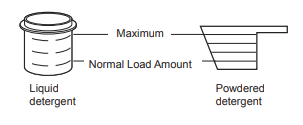
Control Panel

Control Panel Features
1. Power On/Off Button
Press to turn the washer on. Press again to turn the washer off. Pressing the Power button during a cycle will cancel that cycle and any load settings will be lost. The lid (door) will unlock after a brief pause.
NOTE : If there is any water remaining in the tub after the washer shuts off, it will drain following 4 minutes delay. The washer can be restarted any time before the drain begins. However, once the water begins to drain, all functions will be suspended until the water has been completely drained and the washer shuts off.
2. Cycle Selector Knob
Turn this knob to select the desired cycle. Once the desired cycle has been selected, the standard presets will appear in the display. These settings can be adjusted using the cycle modifier buttons anytime before starting the cycle.
NOTE : To protect your clothing, not all settings are available on all cycle selections.
3. Start/Pause Button
Press this button to start the selected cycle. If the washer is running, use this button to pause the cycle without losing the current settings.
NOTE : If Start/Pause is not pressed within 60 minutes of selecting a cycle, the washer automatically turns off and all cycle settings are lost. Any water remaining in the tub will be drained.
4. Cycle Modifier Buttons
Use these buttons to adjust the water temperature, spin speed and soil level settings for the selected cycle. The current settings are shown in the display. Press the button for that option to select other settings.
5. Special Cycle and Option Buttons
Press these buttons to select special cycles or additional cycle options. Certain buttons also allow you to activate special functions by pressing and holding the button for three seconds.
6. Time and Status Display
The display shows the settings, estimated time remaining, options, and status messages for your washer. When the washer is turned on, the default settings in the display will illuminate.
Time and Status Display

1. Door Lock Indicator
The Door Lock indicator will light up once a cycle has started. The indicator light will stay on until the cycle is paused, stopped or has finished.
2. Wi-Fi Connect Indicator
The indicator blinks during product registration and Wi-Fi setup and illuminates when the appliance is connected to a home Wi-Fi network.
3. Cycle Status Indicator
These LEDs illuminate when a cycle is selected to indicate which stages are included. When a cycle is running, the LED for the active stage blinks, and the LEDs for the remaining stages remain steady. Once a stage is complete, the LED turns off. If a cycle is paused, the active stage LED stops blinking.
4. Estimated Time Remaining
When a cycle is selected, the default time for that cycle is displayed. This time will change as modifiers or options are selected. Once the Start/Pause button is pressed, the washer will measure the size of the load. The estimated time may change once the load size has been measured. If Delay Wash is set, the remaining delay time counts down until the cycle begins.
NOTE : The time shown is only an estimate. This time is based on normal operating conditions. Several external factors (load size, room temperature, incoming water temperature,etc.) can affect the actual time.
Wash Cycles
Wash cycles are designed for the best wash performance for each type of load. Select the cycle that best matches the load contents for maximum wash performance and fabric care. See the Sorting Laundry section for best results, follow the fabric care labels on your garments. For a guide to fabric care symbols, see the Sorting Laundry section. Turn the knob or press the button to select the desired cycle. When you select a wash cycle, the light for the corresponding wash cycle will turn on.
NOTE : Whenever load weights are mentioned, assume 1 lb (0.45 kg) = 1 thick bath towel (dry).

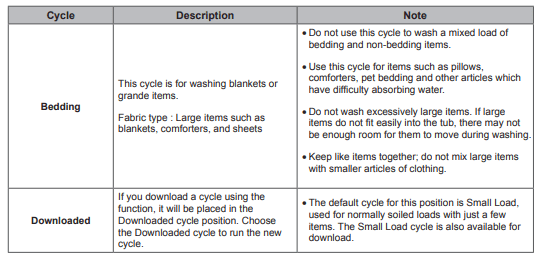
Cycle Guide


Cycle Modifier Buttons
Each cycle has default settings that are selected automatically. You may also customize these settings using the cycle modifier buttons. Press the button for the desired modifier until the indicator light for the desired setting is lit. The washer automatically adjusts the water level for the type and size of wash load for best results and maximum efficiency. Due to the high-efficiency nature of this product, water levels may be much lower than expected. This is normal and cleaning/rinsing performance will not be compromised.
NOTE : To protect your garments, not every wash temperature, spin speed, soil level, or option is available with every cycle. A chime will sound and the LED will not light if a selection is not allowed.
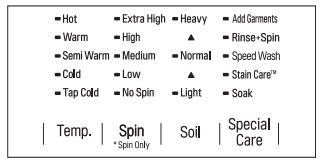
Temp.
Temp. selects the wash and rinse temperature combination for the selected cycle.
- Press the Temp. button until the indicator light for the desired setting is lit.
- All rinses use tap cold water.
NOTE : Select the water temperature suitable for the type of load you are washing. Follow the fabric care labels on the garment for best results.
Spin
Higher spin speeds extract more water from clothes, reducing drying time and saving energy.
- Press the Spin button until the desired speed is selected.
- Some fabrics, such as delicates, require a slower spin speed. To protect your clothing, not all spin speeds are available for all cycles.
Soil
Adjusting the soil level setting will modify the cycle times and/or wash actions.
- Press the Soil button until the desired soil level is selected.
NOTE : This feature needs more time for heavily soiled loads or less time for lightly soiled loads.
Special Care
Press the Special Care button to select additional features, such as Soak, Stain Care, and Rinse+Spin.
- Pressing the Special Care button before selecting a cycle will automatically default to the Normal cycle with the Soak feature selected.
Special Care Features
Press the Special Care button to select specialized cycles or add features to standard cycles. Press the button repeatedly to move through the available features.
NOTE
- To protect your garments, not every feature is available with every cycle.
- If the Start/Pause button is not pressed within 60 minutes to start the cycle, the washer will shut off and all settings will be lost.
Soak
This option provides a 30-minute presoak prior to the start of the selected cycle. Use the Soak option to presoak garments to help remove difficult spots or stains on fabrics. At the end of the presoak time, the selected cycle will begin with the same water used for the soak.
NOTE : You cannot select the Soak option for the Tub Clean cycle.
Stain Care
Use this option for heavily soiled loads that need improved stain treatment. When Stain Care is selected, the wash cycle will begin with warm water to help prevent the setting of certain types of stains. Then, as the cycle progresses, hot water will be added to gradually increase the water temperature to help remove stains that require treatment at higher temperatures.
NOTE
- Best results are obtained with smaller loads (less than 6 lb.)
- If you select Stain Care, the Cold Wash option is not available.
Speed Wash
Use the Speed Wash cycle to quickly wash lightly soiled clothing and small loads. For high wash and rinse efficiency, wash small loads of 2-3 lightly soiled garments.
NOTE : Use very little detergent in this cycle. To add an extra rinse, use the Extra Rinse button.
Rinse+Spin
Select this option to rinse and spin a load separately from a regular cycle. This can be helpful in preventing fresh stains from setting in fabrics. You can change the spin speed by pressing the Spin button.
1. Press the Power button to turn on the washer.
2. Press the Special Care button repeatedly until Rinse+Spin is selected.
3. Press the Start/Pause button.
Special Drain Feature
This washer is equipped with a special drain feature that is designed to make your washer as safe as possible. If the washer is paused or shut off while there is still water in the tub, the water will drain automatically after several minutes of inactivity. This helps keep children safe by reducing the possibility of water remaining in the tub. Any water remaining in the tub will automatically drain 4 minutes after the washer has shut off. If the washer is paused and the Start/Pause button is not pressed within 60 minutes, the washer will shut off and all cycle settings will be lost. And any water remaining in the tub will be drained. The washer can be turned on or restarted any time before the drain begins. However, once the washer begins to drain, all controls and functions will be disabled until the water has been completely drained and the washer shuts off.
Add Garments
If you’ve forgotten to add an item or need to remove foreign objects like coins or keys after the cycle has started, the best time to do so is while the Add Garments indicator is on. Once the indicator turns off, adding garments may affect the cycle time or wash performance.
1. Press Start/Pause. The cycle pauses and the lid (door) unlocks.
2. Open the lid (door), add garments or remove foreign objects, and close the lid (door).
3. Press the Start/Pause button to start the cycle. The cycle continues automatically
Option Buttons
Your washer features several additional cycle options that customize cycles to meet your individual needs. To use these options, select the desired option after selecting the desired cycle. After selecting the desired cycle and settings, press the cycle option button(s) for the option(s) you would like to add. The button will light when that option is selected. If the selected option is not allowed for the selected cycle, the chime will sound twice to alert you and the LED will not illuminate.
NOTE : To protect your garments, not every feature is available with every cycle.
Cold Wash
This option saves energy by using cooler water while increasing the wash and rinse times to maintain wash performance.
NOTE
- Wash time will increase up to several minutes with this option.
- For best wash results, only wash small loads (less than 8 lb.) with this option.
Delay Wash
Once you have selected the cycle and other settings, press this button to delay the start of the wash cycle. Each press of the button increases the delay time by 1 hour, for up to 19 hours. Once the desired delay time is set, press the Start/Pause button to start the delay time.
NOTE : If the Start/Pause button is not pressed to begin the delay time, the washer will automatically shut off after 60 minutes and all cycle settings will be lost.
Water Plus
Use this option to add extra water to the wash cycle for better wash performance (stain treatment) with large items.
NOTE
- If the washer reaches its maximum water level, the Water Plus button will have no effect.
- Selecting the Water Plus option with the Normal cycle automatically changes the cycle to the Deep Wash cycle.
Signal
The washing machine plays a melody when the wash cycle has finished. The volume of the melody is adjusted using the Signal button.
- Press the Signal button repeatedly to adjust the volume of the signal.
- The signal can be turned On or Off. When the LED on the button turns off, the signal is off. The signal volume can be adjusted at any time as long as the washer is turned on.
Extra Rinse
This option will add an extra rinse to the selected cycle. Use this option to help ensure the removal of detergent or bleach residue from fabrics. Liquid fabric softener, if used, is always dispensed in the final rinse.
- Pressing the Extra Rinse button twice will add two additional rinses to the cycle.
NOTE
- You cannot select the Extra Rinse option with the Spin Only option and Tub Clean cycle.
- Selecting the Extra Rinse option with the Normal cycle automatically changes the cycle to the Deep Wash cycle.
Tub Clean
Use this cycle to clean the tub of your washing machine. See the Maintenance section.
Turbo Wash™
Adding the Turbo Wash™ option to a cycle reduces the length of the cycle while maintaining a similar wash performance.
NOTE
- The Turbo Wash™ option cannot be used with all cycles.
- Turbo Wash™ defaults On for Normal, Pre Wash+Normal and Speed Wash cycles.
Control Lock
Use this option to disable the controls. This feature can prevent children from changing cycles or operating the machine. The feature does not lock the lid (door). Once the Control Lock is set, it must be deactivated before any controls, except the Power button, can be used. Once the washer has shut off, the Power button will allow the machine to be turned on, but the controls will still be locked. When the controls are locked, will display alternately with the estimated time remaining.
- Press and hold the Signal button for 3 seconds to activate or deactivate Control Lock.
NOTE : Once the controls are locked, they must be manually unlocked to restore operation.
SMART FUNCTIONS
LG SmartThinQ Application
The LG SmartThinQ application allows you to communicate with the appliance using a smartphone.
Before Using LG SmartThinQ
- For appliances with the
 or
or  logo
logo
1. Use a smartphone to check the strength of the wireless router (Wi-Fi network) near the appliance.
- If the distance between the appliance and the wireless router is too far, the signal strength becomes weak. It may take a long time to register or installation may fail.
2. Turn off the Mobile data or Cellular Data on your smartphone

3. Connect your smartphone to the wireless router.

NOTE
- To verify the Wi-Fi connection, check that Wi-Fi icon on the control panel is lit.
- The appliance supports 2.4 GHz Wi-Fi networks only. To check your network frequency, contact your Internet service provider or refer to your wireless router manual.
- LG SmartThinQ is not responsible for any network connection problems or any faults, malfunctions, or errors caused by network connection.
- The surrounding wireless environment can make the wireless network service run slowly
- If the appliance is having trouble connecting to the Wi-Fi network, it may be too far from the router. Purchase a Wi-Fi repeater (range extender) to improve the Wi-Fi signal strength.
- The network connection may not work properly depending on the Internet service provider.
- The Wi-Fi connection may not connect or may be interrupted because of the home network environment.
- If the appliance cannot be registered due to problems with the wireless signal transmission, unplug the appliance and wait about a minute before trying again.
- If the firewall on your wireless router is enabled, disable the firewall or add an exception to it.
- The wireless network name (SSID) should be a combination of English letters and numbers. (Do not use special characters.)
- Smartphone user interface (UI) may vary depending on the mobile operating system (OS) and the manufacturer.
- If the security protocol of the router is set to WEP, network setup may fail. Change the security protocol (WPA2 is recommended), and register the product again.
Installing the LG SmartThinQ Application
Search for the LG SmartThinQ application from the Google Play Store or Apple App Store on a smart phone. Follow instructions to download and install the application.
LG SmartThinQ Application Features
- For appliances with the
 or
or logo
logo
Washer Cycle (Remote Start, Downloaded)
Set or download any preferred cycle and operate by remote control.
Tub Clean Coach
This function shows how many cycles remain before it is time to run the Tub Clean cycle.
Smart Diagnosis™
This function provides useful information for diagnosing and solving issues with the appliance based on the pattern of use.
Energy Monitoring
The washer energy usage is affected by the cycles and options so you may see some changes in energy usage from one cycle to another.
Push Alerts
When the cycle is complete or the appliance has problems, you have the option of receiving push notifications on a smart phone.
Settings
Set the product nickname and delete product.
NOTE
- If you change your wireless router, Internet service provider, or password, delete the registered appliance from the LG SmartThinQ application and register it again.
- This information is current at the time of publication. The application is subject to change for product improvement purposes without notice to users
Using Washer Cycle
Remote Start
Use a smart phone to control the appliance remotely or check to see how much time is left in the cycle.
Using Remote Start
1. Press the Power button.
2. Load the laundry.
3. Press and hold Remote Start button for 3 seconds to enable the Remote Start function.
4 Start a cycle from the LG SmartThinQ application on your smart phone.
NOTE
- Once the Remote Start mode is enabled, you can start a cycle from the LG SmartThinQ smartphone application. If the cycle is not started, the machine will wait to start the cycle until it is turned off remotely from the application or the Remote Start mode is disabled.
- When Remote Start is turned on, the door is automatically locked.
Disabling Remote Start
When the Remote Start is activated, press and hold the Remote Start button for 3 seconds.
Downloaded
Download new and specialized cycles that are not included in the standard cycles on the appliance. Appliances that have been successfully registered can download a variety of specialty cycles specific to the appliance. Only one cycle can be stored on the appliance at a time.
Once cycle download is completed in the appliance, the appliance keeps the downloaded cycle until a new cycle is downloaded.
Wireless LAN Module Specifications
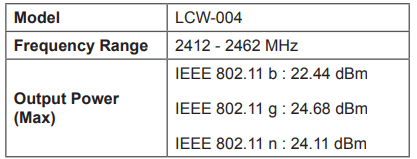
FCC Notice (For transmitter module contained in this product)
This equipment has been tested and found to comply with the limits for a Class B digital device, pursuant to Part 15 of the FCC Rules. These limits are designed to provide reasonable protection against harmful interference in a residential installation. This equipment generates, uses, and can radiate radio frequency energy and, if not installed and used in accordance with the instructions, may cause harmful interference to radio communications. However, there is no guarantee that interference will not occur in a particular installation. If this equipment does cause harmful interference to radio or television reception, which can be determined by turning the equipment off and on, the user is encouraged to try to correct the interference by one or more of the following measures:
- Reorient or relocate the receiving antenna.
- Increase the separation between the equipment and the receiver.
- Connect the equipment to an outlet on a circuit different from that to which the receiver is connected.
- Consult the dealer or an experienced radio/TV technician for help.
This device complies with part 15 of the FCC Rules. Operation is subject to the following two conditions:
1) This device may not cause harmful interference and
2) This device must accept any interference received, including interference that may cause undesired operation of the device.
Any changes or modifications in construction of this device which are not expressly approved by the party responsible for compliance could void the user’s authority to operate the equipment.
FCC RF Radiation Exposure Statement
This equipment complies with FCC radiation exposure limits set forth for an uncontrolled environment. This transmitter must not be co-located or operating in conjunction with any other antenna or transmitter.
This equipment should be installed and operated with a minimum distance of 20 cm (7.8 inches) between the antenna and your body. Users must follow the specific operating instructions for satisfying RF exposure compliance.
Industry Canada Statement (For transmitter module contained in this product)
This device contains licence-exempt transmitter(s)/ receiver(s) that comply with Innovation, Science and Economic Development Canada’s licence-exempt RSS(s). Operation is subject to the following two conditions:
(1) This device may not cause interference.
(2) This device must accept any interference, including interference that may cause undesired operation of the device.
IC Radiation Exposure Statement
This equipment complies with IC radiation exposure limits set forth for an uncontrolled environment.
This equipment should be installed and operated with a minimum distance of 20 cm (7.8 inches) between the antenna and your body.
NOTE : THE MANUFACTURER IS NOT RESPONSIBLE FOR ANY RADIO OR TV INTERFERENCE CAUSED BY UNAUTHORIZED MODIFICATIONS TO THIS EQUIPMENT. SUCH MODIFICATIONS COULD VOID THE USER’S AUTHORITY TO OPERATE THE EQUIPMENT.
Open Source Software Notice Information
LG Electronics will also provide open source code to you on CD-ROM for a charge covering the cost of performing such distribution (such as the cost of media, shipping, and handling) upon email request. This offer is valid for a period of three years after our last shipment of this product. This offer is valid to anyone in receipt of this information.
Smart Diagnosis™ Function
Should you experience any problems with the appliance, it has the capability of transmitting data via your telephone to the LG Customer Information Center. NFC or Wi-Fi equipped models can also transmit data to a smartphone using the LG SmartThinQ application
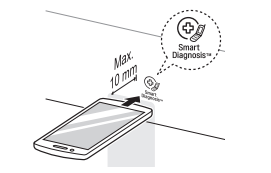
Smart Diagnosis™ through the Customer Information Center
- For appliances with the
 logo
logo
This method allows you to speak directly to our trained specialists. The specialist records the data transmitted from the appliance and uses it to analyze the issue, providing a fast and effective diagnosis.
1. Call the LG Electronics Customer Information Center at: (LG U.S.A.) 1-800-243-0000 (LG Canada) 1-888-542-2623
2. When instructed to do so by the call center, place the mouthpiece of the phone close to the Smart Diagnosis™ icon. Do not press any other buttons.
3. Press and hold Temp. button for three seconds.
4. Keep the phone in place until the tone transmission has finished.
- For best results, do not move the phone while the tones are being transmitted.
- If the call center agent is not able to get an accurate recording of the data, you may be asked to try again.
5 Once the countdown is over and the tones have stopped, resume your conversation with the call center agent, who will then be able to assist you using the information transmitted for analysis.
NOTE
- Smart Diagnosis™ cannot be activated unless the appliance can be turned on using the Power button. If the appliance cannot be turned on, troubleshooting must be done without using Smart Diagnosis™.
- For best results, do not move the phone while the tones are being transmitted.
- If the call center agent is not able to get an accurate recording of the data, you may be asked to try again.
- The Smart Diagnosis™ function depends on the local call quality.
- Bad call quality may result in poor data transmission from your phone to the call center, which could cause Smart Diagnosis™ to malfunction.
LG SmartThinQ Smart Diagnosis™
- For appliances with the or logo
Use the Smart Diagnosis feature in the LG SmartThinQ application for help diagnosing issues with the appliance without the assistance of the LG Customer Information Center.
Follow the instructions in the LG SmartThinQ application to perform a Smart Diagnosis using your smartphone.
NOTE : Smart Diagnosis™ cannot be activated unless the appliance can be turned on using the Power button. If the appliance cannot be turned on, troubleshooting must be done without using Smart Diagnosis™.
MAINTENANCE
WARNING : To reduce the risk of fire, electric shock, or injury to persons, read this entire owner's manual, including the Important Safety Instructions, before operating this washer.
- Unplug the washer before cleaning to avoid the risk of electric shock. Failure to follow this warning can cause serious injury, fire, electric shock, or death.
- Do not use volatile substances (benzene, paint thinner, alcohol, acetone, etc.), abrasive cleaners, or detergents with strong chemical components when cleaning the washer. Doing so may cause discoloration or damage to the machine, or may cause a fire.
- Certain internal parts are intentionally not grounded and may present a risk of electric shock only during servicing. Service personnel-do not contact the following parts while the appliance is energized. : pump, motor, noise filter cover, and heater (on applicable models).
Regular Cleaning
Care After Wash
After the cycle is finished, wipe the lid (door) and the inside of the lid (door) seal to remove any moisture.
- Leave the lid (door) open to dry the tub interior.
- Wipe the body of the washer with a dry cloth to remove any moisture.
Cleaning the Exterior
Proper care of your washer can extend its life.
Lid (Door):
Wash with a damp cloth on the outside and inside and then dry with a soft cloth.
Exterior:
- Immediately wipe off any spills.
- Wipe with a damp cloth.
- Do not touch the surface or the display with sharp objects.
Care and Cleaning of the Interior
- Use a towel or soft cloth to wipe around the washer lid (door) opening and lid (door) glass.
- Always remove items from the washer as soon as the cycle is complete. Leaving damp items in the washer can cause wrinkling, color transfer, and odor.
- Run the Tub Clean cycle once a month, or more often if needed, to remove detergent buildup and other residue.
Cleaning the Tub
Over time, residue may build up in the tub, leading to mildew or a musty odor. Run the Tub Clean cycle monthly to remove residue and prevent odor. Run the cycle more often under heavy use conditions or if odor is already present.
1. Remove any clothing from the tub.
2. Add cleaning agents.
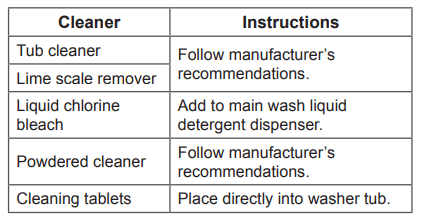
- For other tub cleaning products, follow the cleaner manufacturer’s instructions and recommendations.
- Do not exceed the maximum fill line when adding bleach or powdered cleaners. Powdered cleaners may remain in the tub after cleaning.
3. Close the lid (door) and press the Power button to turn the washer on.
4. Turn the knob or press the cycle buttons to select the Tub Clean cycle then press the Start/Pause button to begin the cycle.
5. After the cycle ends, open the lid (door) and allow the tub interior to dry completely.
NOTE
- Never load laundry while using Tub Clean. The laundry may be damaged or contaminated with cleaning products. Make sure to run the Tub Clean cycle only when the tub is empty.
- Leave the lid(door) open after finishing the laundry, to keep the tub clean.
- Tub Clean should be repeated monthly.
- If mildew or musty smell already exists, run Tub Clean once a week for three consecutive weeks.
- Do not exceed the manufacturer's recommended amount when adding bleach or powdered cleaners. Powdered cleaner may remain in the tub after cleaning.
Removing Mineral Buildup
In areas with hard water, mineral scale can form on internal components of the washer. Periodically clean the mineral buildup on the internal components to extend the lifespan of the washer. Use of a water softener is recommended in areas with hard water.
- Use a descaler, to remove visible mineral buildup on the washer tub.
- After descaling, always run the Tub Clean cycle before washing clothing.
- Mineral scale and other spots may be removed from the stainless steel tub using a soft cloth soaked in stainless steel cleaner.
- Do not use steel wool or abrasive cleaners.
Leaving the Lid (Door) Open
- If the washer will not be used for several days, leave the lid (door) open overnight to allow the tub to dry.
Cleaning the Dispenser Drawer
Detergent and fabric softener may build up in the dispenser drawer. Remove the drawer and inserts and check for buildup once or twice a month.
1. Remove the drawer by pulling it straight out until it stops. Lift up on the front of the drawer and pull it completely out.
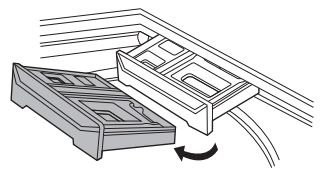
2. Remove the inserts from the two compartments.
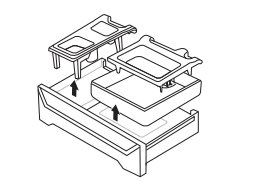
3. Clean the inserts and drawer with warm water.
• Use a soft cloth or brush for cleaning and to remove any residue.
4. Wipe off any moisture with a dry towel or cloth after cleaning.
5. To clean the drawer opening, use a small, nonmetal brush to clean the recess. Remove all residue from the upper and lower parts of the recess.
6. Return the inserts to the proper compartments and replace the drawer.
• Set the drawer into the opening at an angle, then lower it and slide it into place.
NOTE : If you use a descaler or tub cleaner during the Tub Clean cycle, use the Rinse+Spin option to rinse the washer tub before running your next wash cycle.
Cleaning the Bleach Dispenser
Bleach may build up on the bleach dispenser cover. Check for buildup and clean the cover once or twice a month.
Type 1
Remove the cover from the bleach dispenser. Clean the cover and the opening with warm water.
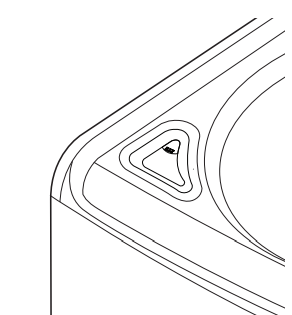
Type 2
The cover cannot be separated from the dispenser. Clean the cover using a brush and warm water.

Cleaning the Water Inlet Filters
If the washer does not fill properly, an error message will show on the display. The inlet valve filter screens could be plugged by hard water scale, sediment in the water supply, or other debris.
1. Turn off both water faucets completely.
2. Unscrew the hot and cold water hoses from the back of the washer.
3. Carefully remove the filters from the water valves.
4. Remove foreign objects and soak the filters in white vinegar or a lime scale remover. If using a lime scale remover, follow the manufacturer’s instructions. Be careful not to damage the filters while cleaning them.
5. Rinse filters thoroughly and press them back into place.
6. Flush then reattach the water hoses. Before reattaching the hoses, flush the hoses and water lines by running several gallons of water into a bucket or drain, preferably with the faucets wide open for maximum flow.
Care in Cold Climates
Storing the Washer
If the washer will not be used for an extended period of time and is in an area that could be exposed to freezing temperatures, perform the following steps to protect the washer from damage. Make sure the tub is empty before following these steps.
1. Turn off the water supply.
2. Disconnect hoses from water supply and drain water from hoses.
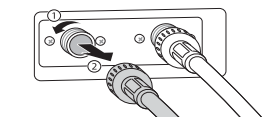
3. Plug the power cord into a properly grounded electrical outlet.
4. Add 1 gallon of nontoxic recreational vehicle (RV) antifreeze to the empty tub and close the lid (door). Never use automotive antifreeze.
5. Press the Power button, then select Spin.
6. Press the Start/Pause button to start the drain pump.
7. Allow the drain pump to run for one minute, then press the Power button to shut off the washer. This will expel some of the antifreeze, leaving enough to protect the washer from damage.
8. Unplug the power cord, dry the tub interior with a soft cloth, and close the lid (door).
9. Store the washer in an upright position.
10. Remove the inserts from the dispenser. Drain any water in the compartments and let them dry.
11. To remove the antifreeze from the washer after storage, run a complete Speed Wash cycle using detergent.
- Do not add laundry to this cycle.
When the Water Line is Frozen
1. Turn off the faucets connected with the water lines.
2. Pour hot water on the frozen faucets to thaw the water lines and remove water lines.
3. Immerse the water lines in hot water to thaw them.
4. Connect the water lines with the water inlets of the washer and with the faucets. See Connecting the Water Lines for details.
5. Turn on the faucets.
6. Press the Power button.
7. Press Special Care button repeatedly to select the Rinse+Spin cycle.
8. Press the Start/Pause button. Verify the water fills properly.
When the Drain Line is Frozen
1. Pour hot water in the washer tub and close the lid. Wait for 1-2 hours.
2. Press the Power button after thawing.
3. Press Special Care button repeatedly to select the Rinse+Spin cycle.
4. Press the Start/Pause button. Check to make sure the water drains.
TROUBLESHOOTING
Noises You Might Hear
Clicking
- Lid (Door) lock relays when the lid (door) locks and unlocks.
- Normal Operation
Spraying or Hissing
- Water spraying or circulating during the cycle.
- Normal Operation
Humming or Gurgling
- Drain pump is pumping water from the washer at times during a cycle.
- Normal Operation
Water sloshing
- A liquid in the balance ring around the wash basket helps the basket spin smoothly.
- Normal Operation
Water being added after the washer has already begun to operate
- The washer adapts to the load size and type to add more water to the cycle as needed.
- The wash load may be unbalanced. If the washer senses that the load is unbalanced, it will stop and refill to redistribute the load.
- The washer may be diluting laundry additives to add to the wash load.
- Normal Operation
Rattling and clanking noise
- Foreign objects, such as keys, coins, or safety pins may be in tub or pump.
- Stop washer, check tub and drain filter for foreign objects. If noise continues after washer is restarted, call for service.
Thumping sound
- Heavy wash loads may produce a thumping sound.
- This is normal. If sound continues, washer is probably out of balance. Stop and redistribute wash load.
- Wash load may be out of balance.
- Pause the cycle and redistribute the load after the lid (door) unlocks.
Vibrating noise
- Packaging materials were not removed.
- See Unpacking and Removing Shipping Material in the Installation section
- Wash load may be unevenly distributed in the drum.
- Pause the cycle and redistribute the load after the lid (door) unlocks.
- Not all leveling feet are resting firmly and evenly on the floor.
- See Leveling the Appliance in the Installation section.
- Floor not rigid enough.
- Make sure that the floor is solid and does not flex. See Flooring in the Installation section.
Squeaking noise
- Packaging materials were not removed.
- See Unpacking and Removing Shipping Material in the Installation section.
Banging noise when washer is filling with water (Water Hammer)
- Plumbing in the home moves or flexes when the water valves in the washer shut off.
- Water hammer is not caused by a defect in the washer. Install water hammer arrestors (purchased separately at hardware or home improvement store) between the fill hose and the washer for best results.
- Household water supply pressure is very high.
- Adjust household water supply regulator to a lower pressure or contact a plumber.
Water leaking
- Hoses are not connected correctly.
- Check hoses and connectors for leaks, cracks and splits.
- Check and tighten hose connections
- House drain pipes are clogged.
- The washer pumps out water very rapidly. Check for water backing up out of the drain pipe during drain. If water is seen coming out of the drain, check for proper drain hose installation and check for restrictions in the drain. Contact a plumber to repair drain pipe.
- Drain hose has come out of drain connector or is not inserted far enough.
- Tie drain hose to inlet hose or standpipe to prevent it from coming out during drain. For smaller drain pipes, insert the drain hose into the pipe as far as the drain hose flange. For larger drain pipes, insert the drain hose into the pipe 1-2 inches past the flange
- A large item such as a pillow or blanket is above the top of the tub.
- Use the Bedding cycle for large or bulky items. Use extra care and never wash more that half a load of items that float, such as pillows.
- Stop the washer and check the load. Make sure the load does not crest above the top edge of the tub.
- Oversudsing of detergent.
- Oversudsing may create leaks, and may be caused by the type and amount of detergent used. High-Efficiency detergent is the only detergent recommended. The normal amount of detergent to use is 1/4 to 1/2 of the maximum amount recommended by the detergent manufacturer. Always reduce the amount of detergent if the load is small or lightly soiled, or if the water is very soft. Never use more than the maximum amount recommended by the detergent manufacturer.
Water leaks every load.
- Hoses are not installed correctly.
- Check all fill and drain hose connections to ensure that they are tight and secure.
Excessive sudsing
- Too much detergent or incorrect detergent.
- HE detergents are formulated specifically for High-Efficiency washers and contain sudsreducing agents. Only use detergent with the High-Efficiency (HE) logo.
- For detergent quantities refer to the Detergent Use section. If sudsing or detergent residue continue to be an issue, add an extra rinse.
Washer will not turn on.
- Power cord is not properly plugged in.
- Make sure that the plug is plugged securely into a grounded, 3-prong, 120-VAC, 60 Hz outlet.
- House fuse is blown, circuit breaker has tripped, or power outage has occurred.
- Reset circuit breaker or replace fuse. Do not increase fuse capacity. If the problem is a circuit overload, have it corrected by a qualified electrician
Wash cycle time is longer than usual.
- The washer automatically adjusts the wash time for the amount of laundry, water pressure and other operating conditions.
- This is normal. The washer adjusts cycle time automatically to provide optimal results for the selected cycle. The time remaining shown in the display is only an estimate. Actual time may vary
Incomplete or no dispensing of detergent
- Too much detergent used.
- Make sure that the suggested amount of detergent is used per the manufacturer’s recommendations. You may also dilute the detergent with water to the maximum fill line on the compartment to avoid clogging. Use only HE (High-Efficiency) detergent.
NOTE: Always use as little detergent as possible. High-Efficiency washers need very little detergent to achieve optimum results. Using too much detergent will cause poor wash and rinse performance and may contribute to odors in washer
- Insufficient water supply.
- Make sure that both hot and cold water faucets are turned on all the way
- Normal residue.
- It is normal for a small amount of detergent to remain in the dispenser. If this residue builds up it can interfere with normal dispensing of products. Refer to the cleaning instructions.
Washer will not operate.
- Control panel has powered off due to inactivity.
- This is normal. Press the Power button to turn the washer on.
- Washer is unplugged.
- Make sure cord is plugged securely into a working outlet.
- Water supply is turned off.
- Turn both hot and cold faucets fully on.
- Controls are not set properly.
- Make sure the cycle was set correctly, close the lid (door) and press the Start/Pause button.
- Lid (Door) is open.
- The washer will not operate if the lid (door) is open. Close the lid (door) and make sure that nothing is caught under the lid (door) preventing it from closing completely.
- Circuit breaker/fuse is tripped/ blown.
- Check house circuit breakers/fuses. Replace fuses or reset breaker. The washer should be on a dedicated branch circuit. The washer will resume the cycle where it stopped once power is restored.
- Control needs to be reset.
- Press the Power button, then re-select the desired cycle and press the Start/Pause button.
- Start/Pause was not pressed after a cycle was set.
- Press the Power button then re-select the desired cycle and press the Start/Pause button. The washer will shut off if the Start/Pause button is not pressed within 60 minutes.
- Extremely low water pressure.
- Check another faucet in the house to make sure that household water pressure is adequate.
- Washer is too cold.
- If the washer has been exposed to temperatures below freezing for an extended period of time, allow it to warm up before pressing the Power button. Otherwise, the display will not come on.
Washer is not filling properly
- Filter clogged.
- Make sure the inlet filters on the fill valves are not clogged. Refer to the filter cleaning instructions.
- Inlet hoses may be kinked.
- Check that inlet hoses are not kinked or clogged.
- Energy efficiency
- This is a High-Efficiency (HE) washer. As a result, the water level settings for this washer may be different than for conventional washers.
- Insufficient water supply
- Make sure that both hot and cold water faucets are turned on all the way.
- The washer lid (door) is open.
- The washer will not operate if the lid (door) is open. Close the lid (door) and make sure that nothing is caught under the lid (door) preventing it from closing completely.
- Water level is too low.
- The water will not normally cover the clothes. The fill level is optimized for the wash motion to achieve the best wash performance.
Water in the washer does not drain or drains slowly.
- Drain hose is kinked, pinched, or clogged.
- Make sure the drain hose is free of clogs, kinks, etc., and is not pinched behind or under the washer.
- Drain discharge is more than 96 inches (2.4 m) above bottom of washer.
- Move the end of the drain hose so it’s lower than 96 inches (2.4 m) above the bottom of the washer
Bleach does not dispense
- Bleach dispenser cover is not properly installed.
- Make sure that the bleach cover is properly installed and snapped into place before the beginning of the cycle.
- Bleach dispenser is dirty or clogged.
- Lift out the bleach dispenser cover and clean out the reservoir. Lint and other foreign debris that collects in the inside the dispenser may prevent proper dispensing of the bleach.
Premature dispensing of bleach
- Bleach dispenser filled for future load.
- You cannot store bleach in the dispenser for future use. The bleach will be dispensed every load.
- Overfilling the bleach dispenser.
- Overfilling the bleach dispenser will cause the bleach to dispense immediately, which will damage the laundry or the washer. Always measure bleach, but never fill above the max line on the dispenser. A half cup of bleach is sufficient for most loads. Never use more than 1 cup of bleach.
Wrinkling
- Washer not unloaded promptly.
- Always remove items from the washer as soon as the cycle is complete.
- Washer overloaded.
- The washer can be fully loaded, but the tub should not be tightly packed with items. The lid (door) of the washer should close easily.
- Hot and cold water inlet hoses are reversed.
- Hot water rinse can set wrinkles in garments. Check the inlet hose connections.
Staining
- Bleach or softener dispensed too soon.
- Dispenser compartment is overfilled causing bleach or softener to dispense immediately. Always measure bleach to prevent overfilling one cup maximum.
- Dispenser drawer closed too quickly causing softener to dispense immediately.
- Bleach or softener was added directly to the wash load in the tub.
- Always use the dispensers to ensure that laundry produdcts are properly dispensed at the right time in the cycle.
- Washer was not unloaded promptly.
- Always remove items from the washer as soon as possible after the cycle is complete.
- Clothes were not properly sorted.
- Always wash dark colors separately from light colors and whites to prevent discoloration.
- Never wash heavily soiled items with lightly soiled items.
Poor stain removal
- Proper options not selected.
- Heavier soils and tougher stains may require extra cleaning power. Select the Soak or Stain Care feature to boost the cleaning power of the selected cycle.
- Previously set stains.
- Articles that have previously been washed may have stains that have been set. These stains may be difficult to remove and may require hand washing or pre-treating to aid in stain removal.
Musty or mildewy odor in washer
- Incorrect or too much detergent has been used.
- Use only High-Efficiency (HE) detergent in accordance with the manufacturer’s instructions.
- Inside of tub was not cleaned properly.
- Run the Tub Clean cycle regularly.
Trouble connecting appliance and smartphone to Wi-Fi network
- The password for the Wi-Fi network was entered incorrectly.
- Delete your home Wi-Fi network and begin the registration process again.
- Mobile data for your smartphone is turned on.
- Turn off the Mobile data on your smartphone before registering the appliance.
- The wireless network name (SSID) is set incorrectly.
- The wireless network name (SSID) should be a combination of English letters and numbers. (Do not use special characters.)
- The router frequency is not 2.4 GHz.
- Only a 2.4 GHz router frequency is supported. Set the wireless router to 2.4 GHz and connect the appliance to the wireless router. To check the router frequency, check with your Internet service provider or the router manufacturer.
- The distance between the appliance and the router is too far.
- If the appliance is too far from the router, the signal may be weak and the connection may not be configured correctly. Move the router closer to the appliance or purchase and install a Wi-Fi repeater.
Error Codes

- If the balance is not successful, this error will be displayed.
- The automatic attempt to rebalance the load was not successful. The cycle has been paused to allow the load to be manually adjusted.
- The load is too small.
- Small loads may need additional items to be added to allow the washer to balance the load.
- Heavy articles are mixed with lighter items.
- The load may have heavy items loaded with lighter items. Always try to wash articles of somewhat similar weight to allow the washer to evenly distribute the weight of the load for spinning.
- The load is out of balance.
- Manually redistribute the load if articles have become tangled preventing the automatic rebalancing from working properly.

- Water supply faucets are not fully open.
- Make sure that the water faucets are fully open.
- Water line hoses are kinked, pinched, or crushed.
- Make sure that the hoses are not kinked or pinched. Be careful when moving the washer.
- Water inlet filters are clogged.
- Clean the inlet filters. See Maintenance section.
- Water supply pressure to faucet or house is too low.
- Check another faucet in the house to make sure that household water pressure is adequate and flow is not restricted. Disconnect the inlet hose from the washer and run a few gallons of water through the hose to flush the water supply lines. If flow is too low, contact a plumber to have the water lines repaired.
- Water supply connected with leaklimiting hoses.
- Hoses designed to limit leaks can trip falsely and prevent the washer from filling. The use of leak limiting hoses is not recommended.

- Drain hose is kinked, pinched, or clogged.
- Make sure the drain hose is free of clogs or kinks and is not pinched behind or under the washer.
- Drain discharge is more than 96 inches (2.4 m) above bottom of washer.
- Move the end of the drain hose so it’s lower than 96 inches (2.4 m) above the bottom of the washer

- The Control Lock function is on to prevent anyone from changing cycles or operating the appliance.
- Turn off Control Lock in the control panel. See Control Lock under Option Buttons.

- Special drain feature
- If the washer is paused during a cycle for more than 4 minutes, the cycle will be cancelled and any water remaining in the tub will be drained.
- This is not an error code. It indicates that the drain function is operating.

- Lid (Door) is not closed properly.
- Close the lid (door) and press Start/Pause button. After starting a cycle, it may take a few moments before the tub begins to turn or spin. The washer will not spin unless the lid (door) is locked.
- If the error persists once the lid (door) is closed and the Start/Pause button is pressed, call for service.

- Lid (Door) lock switch error.
- Make sure that the lid (door) is closed properly and press the Start/Pause button. The washer will not operate unless the lid (door) is locked.
- Make sure that nothing is caught under the lid (door), including shipping material or clothing.
- Make sure that the latch mechanism is fully retracted.
- If the lid (door) is closed and the lid (door) lock error message is displayed, call for service.

- Foreign objects such as coins, pins, clips, etc., caught between the wash plate and the inner basket.
- Turn the washer off then on again. Press the Spin button without selecting a cycle to drain and spin the load.
- When the Spin cycle is complete, empty the tub and find and remove any objects caught in the wash plate.
- Always check pockets, etc., before washing to prevent error codes or damage to the washer or clothing.

- It is time to run the Tub Clean cycle
- Run the Tub Clean cycle

- The washer has detected an out of balance load.
- If the washer detects a load that is too far out of balance to spin, it will display this code while it is attempting to rebalance the load. The washer will add water and try to redistribute the load automatically. This display is for your information only, and no action is required.
- As a result, the cycle will take longer than initially estimated

- Control error.
- Unplug the washer and wait 60 seconds. Reconnect power and try again. If the error reappears, call for service.

- Water level is too high due to a faulty water valve.
- Close the water faucets, unplug the washer, and call for service.

- The water level sensor is not working correctly.
- Close the water faucets, unplug the washer, and call for service.

- A motor error has occurred.
- Allow the washer to stand for 30 minutes and then restart the cycle. If the LE error code persists, call for service.

- Clutch error
- Mechanical failure
- Unplug the washer and call for service
See other models: LFXS30766D GSM760PZXZ DLE7200WE GBB60MCPFS LFXS28596D
